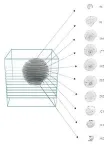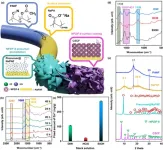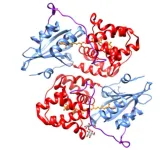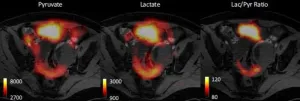(Press-News.org) Hailstones are formed during thunderstorms, when raindrops are propelled into very cold parts of a cloud, where they freeze. Once the particles are heavy enough, gravity pulls them back towards Earth. As the plummet, they grow into hailstones, which can cause injury to people and significant damage to homes and cars.
Scientists have been studying how hailstones grow since the 1960s but doing so meant breaking them in the process. To better understand the anatomy and growth of hailstones, researchers in Catalonia have used computed tomography (CT) scans to examine the giant hailstones that hit the north-east of the Iberian Peninsula during an exceptionally strong thunderstorm in the summer of 2022.
“We show that the CT scanning technique enables the observation of the internal structure of the hailstones without breaking the samples,” said Carme Farnell Barqué, a researcher at the Meteorological Service of Catalonia and lead author of the study published in Frontiers in Environmental Science. “It is the first time that we have a direct observation of the entire internal structure of hailstones, which can provide clues to improve hail formation forecasting.”
Storm hunters
After the storm hit Catalonia on August 30, 2022, the researchers tracked the storm path with the help of local witnesses and collected hailstones from observers who’d saved them in their freezers. Some of the stones measured up to 12cm in diameter.
Back in the lab, three randomly selected hailstones were scanned, using the equipment of a dental clinic. The research was funded by the Institut de Recerca de l’Aigua and a grant from Agència de Gestió d’Ajuts Universitaris i de Recerca.
“We wanted to use a technique that would provide more information regarding the internal layers of the hailstones, but without breaking the samples,” said senior author Prof Xavier Úbeda, a researcher at the University of Barcelona. “We didn’t expect to obtain as clear imagery as we got.”
By way of CT scan, a technology that uses a rotating X-ray machine to create 3D images, the researchers learned much about the external and internal structure of hailstones. 512 images – known as ‘slices’ – of each hailstone showed the location of the core and different layers. “CT scans provide information related to the density, which allows us to identify the different stones’ layers associated with the growth stages of the hailstorm. They also help us understand the processes that contributed to its formation,” explained co-author Prof Javier Martin-Vide, a researcher at the University of Barcelona.
Anatomy of a hailstone
The researchers found that axes and planes can be irregular on the inside, even when from the outside, stones look like near-perfect spheres. Additionally, the stones’ cores were not located in the centers, especially in spherical stones. “We show that the embryo can be located far from the center. This fact implies that the stones can grow heterogeneously in three directions,” co-author Dr Tomeu Rigo Ribas at the Meteorologic Service of Catalonia pointed out.
They also found that different layers had different density levels, and two of the samples had thicker parts, which indicates this was the side of the stone facing downwards as it fell.
These insights into the insides of hailstones overturned previous assumptions. “Until now, it was believed that very large hailstones could only have irregular shapes. However, we observed that the external and internal shapes can differ,” said Farnell Barqué. “In one case, we have demonstrated that the sample exhibited heterogeneous growth but had a regular external shape. Conversely, stones with irregular external shapes showed homogeneous growth.”
Making CT scans, however, is expensive, and some of the resulting images show anomalies they yet have to understand, the researchers said. As more giant hail events with greater impacts on economy and people are expected in the future, they believe that their work can provide new information that may help mitigate damage to society.
END
3D scans of giant hailstones reveal surprising discoveries that could help predict future storms
Scientists used CT scans to learn more about the anatomy of hailstones, information which could advance hail formation forecasting
2024-12-06
ELSE PRESS RELEASES FROM THIS DATE:
Developing highly efficient recovery materials for precious 'rare earth metals' and improving resource circulation for digital infrastructure
2024-12-06
Korea imports 95% of its core minerals such as lithium, nickel, and rare earths. Rare earths, in particular, are characterized by chemical, electrical, magnetic, and luminescent properties that can be achieved by adding only a small amount, and their use has recently increased significantly as core materials in the eco-friendly automobile and renewable energy industries. China, a major producer of rare metals, is controlling the supply through its strategy of weaponizing resources, putting great pressure on the domestic industry.
Dr. Jae-Woo Choi and his team at the Center for Water Cycle Research at the Korea Institute of Science ...
Autonomous imaging robot plays a crucial role in assessing embryos’ response to environmental change
2024-12-06
Scientists have used 3D-printed components to create a robotic instrument that can autonomously monitor the earliest stages of development in any aquatic species.
The LabEmbryoCam has been created over the past decade by biologists and technologists from the EmbryoPhenomics research group at the University of Plymouth.
It can be used to track embryonic development, a fundamental biological process that underpins the diversity of life on Earth, and provides an accessible and scalable means of visualising and measuring this process in large ...
Entrepreneurs who take funding from close family and friends are more likely to pursue lower-risk growth options
2024-12-06
BLOOMINGTON, Ind. – Entrepreneurs often lack resources and funding needed to launch a venture and reach out to family and friends for initial support. But is it always good for a startup when individuals close to the founder are asked if they want to “be on the ground floor of something good?”
New research from three Indiana University Kelley School of Business professors finds that such close ties to investors can lead founders to make more conservative venture growth decisions and make them more hesitant to take risks.
“In this study we were seeking to understand how accepting funds from these individuals influences an entrepreneur’s risk-taking preferences,” ...
A quantum leap in carotenoid analysis: Speed and precision unlocked
2024-12-06
Carotenoids, the pigments responsible for the vibrant hues of tomatoes, carrots, and some seafood, are well-regarded for their antioxidant effects and health benefits. A few examples of commercially significant carotenoids are lycopene, β-carotene, and astaxanthin. These compounds are frequently used in functional foods, skincare products, and dietary supplements. However, the bioactivity of these carotenoids depends heavily on their isomeric form, with Z-isomers typically showing higher biological activity but being more challenging to quantify. Traditional methods often require months of analysis and can produce error rates reaching up to 100 %.
In this view, a team ...
Kumamoto University researchers discover groundbreaking antidiabetic compound
2024-12-06
Kumamoto University scientists have unveiled a novel compound, HPH-15, with dual effects of reducing blood glucose levels and combating fat accumulation, marking a significant leap in diabetes treatment innovation.
Type 2 diabetes, a condition affecting millions worldwide, is often accompanied by complications like fatty liver and insulin resistance, which challenge current treatment methods. The research team, led by Visiting Associate Professor Hiroshi Tateishi and Professor Eiichi Araki, has identified HPH-15 as a promising alternative to existing medications like metformin.
The study, published in Diabetologia, a top journal in the field of diabetes, demonstrates ...
Imaging technique allows rapid assessment of ovarian cancer subtypes and their response to treatment
2024-12-06
An MRI-based imaging technique developed at the University of Cambridge predicts the response of ovarian cancer tumours to treatment, and rapidly reveals how well treatment is working, in patient-derived cell models.
The technique, called hyperpolarised carbon-13 imaging, can increase the detected signal in an MRI scanner by more than 10,000 times. Scientists have found that the technique can distinguish between two different subtypes of ovarian cancer, to reveal their sensitivities to treatment.
They used it to look at patient-derived cell models that closely mimic the behaviour of human high grade serous ovarian cancer, ...
Genetic study of native hazelnut challenges misconceptions about how ancient Indigenous peoples used the land
2024-12-06
By decoding the DNA of the beaked hazelnut (Corylus cornuta), a native plant that thrives in British Columbia, a team of multidisciplinary scientists is providing new insight into how ancestral Indigenous peoples stewarded plants across the province.
Led by Chelsey Geralda Armstrong, an assistant professor in Simon Fraser University’s (SFU) Department of Indigenous Studies, the innovative study was recently published in the Proceedings of the National Academy of Science (PNAS), a major scientific journal.
“The misconception that Indigenous ...
Greater patient education needed around antidepressants which may reduce genital sensitivity, SFU study finds
2024-12-06
The use of antidepressants is associated with sexual side effects including reduced genital sensitivity that persists after stopping the medication, a new Simon Fraser University study finds.
The study, published in Social Psychiatry and Psychiatric Epidemiology, indicates that 13 per cent of people who used antidepressants reported a reduction in genital sensitivity, compared to one per cent of users of other psychiatric medications.
“It’s gone under the radar for so long, largely due to stigma, shame and embarrassment,” says Yassie Pirani, an SFU alumnus and lead author on the study. ...
Increases in US life expectancy forecasted to stall by 2050, poorer health expected to cause nation’s global ranking to drop
2024-12-06
SEATTLE, Wash., Dec. 5, 2024 – The U.S. is failing to keep pace with dozens of countries around the world due to the steady decline of the nation’s health progress, according to a detailed analysis of all 50 states and Washington, D.C., published in The Lancet. Researchers at the Institute for Health Metrics and Evaluation (IHME) produced health estimates and forecasts (the most likely future) of life expectancy, mortality, and morbidity due to more than 350 diseases and injuries and 68 risks in the U.S. from 1990 to 2050.
U.S. life expectancy improvements slow, global ranking drops
Life expectancy (LE) in the U.S. is forecasted to increase from ...
Gut microbiota: A consensus paper to regulate the "wild west" of diagnostic tests
2024-12-06
The gut microbiota might perhaps one day become a routine tool for the early diagnosis of many diseases and to guide treatment, but at present there is a lack of solid scientific evidence to support these claims. Yet, day by day, there are more and more offers of commercial kits for do-it-yourself testing, at the moment totally lacking in meaning and scientific solidity. To put a stop to this drift, an international panel of experts, coordinated by Dr Gianluca Ianiro, has drawn up ‘instructions for use’ for best practice in microbiota testing and recommendations for its indications, methods of analysis, presentation of results and potential clinical ...
LAST 30 PRESS RELEASES:
Making lighter work of calculating fluid and heat flow
Normalizing blood sugar can halve heart attack risk
Lowering blood sugar cuts heart attack risk in people with prediabetes
Study links genetic variants to risk of blinding eye disease in premature infants
Non-opioid ‘pain sponge’ therapy halts cartilage degeneration and relieves chronic pain
AI can pick up cultural values by mimicking how kids learn
China’s ecological redlines offer fast track to 30 x 30 global conservation goal
Invisible indoor threats: emerging household contaminants and their growing risks to human health
Adding antibody treatment to chemo boosts outcomes for children with rare cancer
Germline pathogenic variants among women without a history of breast cancer
Tanning beds triple melanoma risk, potentially causing broad DNA damage
Unique bond identified as key to viral infection speed
Indoor tanning makes youthful skin much older on a genetic level
Mouse model sheds new light on the causes and potential solutions to human GI problems linked to muscular dystrophy
The Journal of Nuclear Medicine ahead-of-print tip sheet: December 12, 2025
Smarter tools for peering into the microscopic world
Applications open for funding to conduct research in the Kinsey Institute archives
Global measure underestimates the severity of food insecurity
Child survivors of critical illness are missing out on timely follow up care
Risk-based vs annual breast cancer screening / the WISDOM randomized clinical trial
University of Toronto launches Electric Vehicle Innovation Ontario to accelerate advanced EV technologies and build Canada’s innovation advantage
Early relapse predicts poor outcomes in aggressive blood cancer
American College of Lifestyle Medicine applauds two CMS models aligned with lifestyle medicine practice and reimbursement
Clinical trial finds cannabis use not a barrier to quitting nicotine vaping
Supplemental nutrition assistance program policies and food insecurity
Switching immune cells to “night mode” could limit damage after a heart attack, study suggests
URI-based Global RIghts Project report spotlights continued troubling trends in worldwide inhumane treatment
Neutrophils are less aggressive at night, explaining why nighttime heart attacks cause less damage than daytime events
Menopausal hormone therapy may not pose breast cancer risk for women with BRCA mutations
Mobile health tool may improve quality of life for adolescent and young adult breast cancer survivors
[Press-News.org] 3D scans of giant hailstones reveal surprising discoveries that could help predict future stormsScientists used CT scans to learn more about the anatomy of hailstones, information which could advance hail formation forecasting







